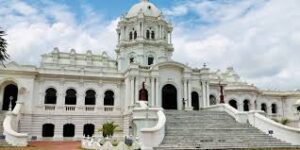Ujjayanta Palace, one of the most iconic landmarks in Tripura, is a majestic reminder of the state’s royal past and a popular destination for tourists. Located in the heart of Agartala, the capital city, the palace is a striking example of Indo-Saracenic architecture, blending elements of Mughal, British, and local Tripuri styles. Its grandeur and historical significance have made it a central point for both history enthusiasts and travelers seeking to explore the rich cultural heritage of the region.
The Ujjayanta Palace was built in the early 20th century during the reign of Maharaja Radha Kishore Manikya, who commissioned its construction in 1899. The palace served as the royal residence of the Manikya dynasty, the rulers of Tripura. It is believed that the palace was designed by the renowned British architect Sir H.C. Lanchester, and its construction took over a decade to complete, finally finishing in 1901. The palace stands as a symbol of the prosperity and grandeur of the Tripuri kings during their reign.

The name “Ujjayanta” is derived from the Sanskrit word “Ujjayanta,” meaning “the victorious.” It is said to be inspired by the palace’s opulence and the victory of the Manikya dynasty in the region. The palace complex is set in sprawling grounds with beautiful gardens, ponds, and fountains, adding to its royal charm.
Over the years, Ujjayanta Palace witnessed several significant events, including the coronation of kings and important cultural events. However, after the merger of Tripura with India in 1949, the palace ceased to function as a royal residence and was eventually handed over to the government. In the 21st century, the palace was transformed into a museum, showcasing the history, culture, and heritage of Tripura. Today, it serves as an important site for preserving the legacy of the Manikya dynasty and the region’s royal past.
The architectural beauty of Ujjayanta Palace is a blend of Mughal, European, and local influences. The palace features grand arches, domes, and intricate carvings that reflect the royal taste of its time. The main building is three stories high, with spacious verandas, open courtyards, and large windows. The interior is equally spectacular, with ornate wooden staircases, lavish decor, and rich furnishings that speak volumes about the era’s opulence.
The surrounding gardens are meticulously landscaped with lush greenery, offering a tranquil atmosphere for visitors. The palace also boasts several ponds and fountains, enhancing its regal beauty. The serene environment surrounding the palace adds to its charm, making it an ideal spot for photography and leisure walks.
Ujjayanta Palace is a key tourist attraction in Tripura, offering a deep dive into the state’s royal history. The palace has been converted into a museum, housing an extensive collection of artifacts, sculptures, paintings, and antique items that depict the cultural and historical heritage of Tripura. It provides a unique opportunity to explore the rich past of the Manikya dynasty, including their lifestyle, customs, and governance.

Visitors can explore the royal living quarters, historical exhibits, and the royal throne, while learning about the integration of Tripura with India post-independence. The museum also features exhibits related to Tripura’s tribal cultures, giving visitors an insight into the diversity of the state’s indigenous communities.
In addition to its historical significance, Ujjayanta Palace plays an important role in the tourism culture of Tripura. It attracts both domestic and international tourists who are eager to learn about the state’s heritage. The palace also plays host to various cultural events, exhibitions, and performances, often showcasing local music, dance, and art. These events promote Tripura’s unique cultural identity and encourage greater tourism in the region.
Ujjayanta Palace is not just a symbol of Tripura’s royal history, but also a beacon of the state’s vibrant tourism culture. Its architectural splendor, historical significance, and cultural offerings make it a must-visit destination for anyone exploring Tripura. The palace stands as a testament to the state’s royal past and is a valuable asset in preserving and showcasing Tripura’s heritage to the world.
















